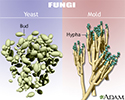Skin or nail culture
Mucosal culture; Culture - skin; Culture - mucosal; Nail culture; Culture - fingernail; Fingernail culture
A skin or nail culture is a laboratory test to look for and identify germs that cause problems with the skin or nails.
It is called a mucosal culture if the sample involves the mucous membranes.
How the Test is Performed
The health care provider may use a cotton swab to collect a sample from an open skin rash or skin sore.
A sample of skin may need to be taken. This is called a skin biopsy . Before the skin sample is removed, you will likely receive a shot (injection) of numbing medicine to prevent pain.
Skin biopsy
A skin lesion biopsy is when a small amount of skin is removed so it can be examined. The skin is tested to look for skin conditions or diseases. A...

A small sample of a fingernail or toenail may be taken. The sample is sent to a lab. There, it is placed in a special dish (culture). It is then watched to see if bacteria, viruses, or fungi grow. It may take up to 3 weeks to get results of a nail culture. Further tests can be done to identify the specific germ that is causing your problem. This can help your provider determine the best treatment.
How to Prepare for the Test
There is no preparation needed for this test. If a skin or mucosal sample is needed, your provider will tell you how to prepare.
Mucosal
A gum biopsy is a surgery in which a small piece of gingival (gum) tissue is removed and examined.

How the Test will Feel
If a skin sample is taken, you may feel a sting when the shot of numbing medicine is given.
For a nail sample, the provider scrapes the affected area of the nail. There is usually no pain.
Why the Test is Performed
This test may be done to diagnose the cause of:
- A bacteria or fungus infection of the skin, finger, or toenail
- A skin rash or sore that appears to be infected
- A skin ulcer that is not healing
Normal Results
A normal result means no disease-causing germs are seen in the culture.
Some germs normally live on the skin. These are not a sign of infection and are considered a normal finding.
Normal value ranges may vary slightly among different laboratories. Some labs use different measurements or test different samples. Talk to your provider about the meaning of your specific test results.
What Abnormal Results Mean
An abnormal result means bacteria, fungus, or virus is present. This may be a sign of infection.
Common skin infections caused by bacteria include:
- Impetigo
-
Diabetes foot ulcers
Diabetes foot ulcers
If you have diabetes, you have an increased chance of developing foot sores, or ulcers, also called diabetic ulcers. Foot ulcers are a common reason ...
Read Article Now Book Mark Article
Common skin infections caused by fungus include:
-
Athlete's foot
Athlete's foot
Athlete's foot is an infection of the feet caused by fungus or yeast. The medical term is tinea pedis, or ringworm of the foot.
 ImageRead Article Now Book Mark Article
ImageRead Article Now Book Mark Article -
Nail infections
Nail infections
Fungal nail infection is a fungus growing in and around your fingernail or toenail.
 ImageRead Article Now Book Mark Article
ImageRead Article Now Book Mark Article -
Scalp infections
Scalp infections
Nummular eczema is a dermatitis (eczema) in which itchy, coin-shaped spots or patches appear on the skin. The word nummular is Latin for "resembling...
 ImageRead Article Now Book Mark Article
ImageRead Article Now Book Mark Article
Risks
Risks include slight bleeding or infection in the area where the skin sample was removed.
References
Croft AC, Woods GL. Specimen collection and handling for diagnosis of infectious diseases. In: McPherson RA, Pincus MR, eds. Henry's Clinical Diagnosis and Management by Laboratory Methods . 22nd ed. Philadelphia, PA: Elsevier Saunders; 2011:chap 63.
High WA, Tomasini CF, Argenziano G, Zalaudek I. Basic principles of dermatology. In: Bolognia JL, Jorizzo JL, Schaffer JV, eds. Dermatology . 3rd ed. Philadelphia, PA: Elsevier Saunders; 2012:chap 0.
-
Yeast and mold - illustration
Mold and yeast are two types of fungus. Both can cause allergic reactions. Fungal spores can circulate in the air and may cause allergic rhinitis when inhaled.
Yeast and mold
illustration
-
Wounds
(Alt. Medicine)
-
Lyme disease and related tick-borne infections
(In-Depth)
Review Date: 8/14/2015
Reviewed By: Linda J. Vorvick, MD, Medical Director and Director of Didactic Curriculum, MEDEX Northwest Division of Physician Assistant Studies, Department of Family Medicine, UW Medicine, School of Medicine, University of Washington, Seattle, WA. Also reviewed by David Zieve, MD, MHA, Isla Ogilvie, PhD, and the A.D.A.M. Editorial team.


